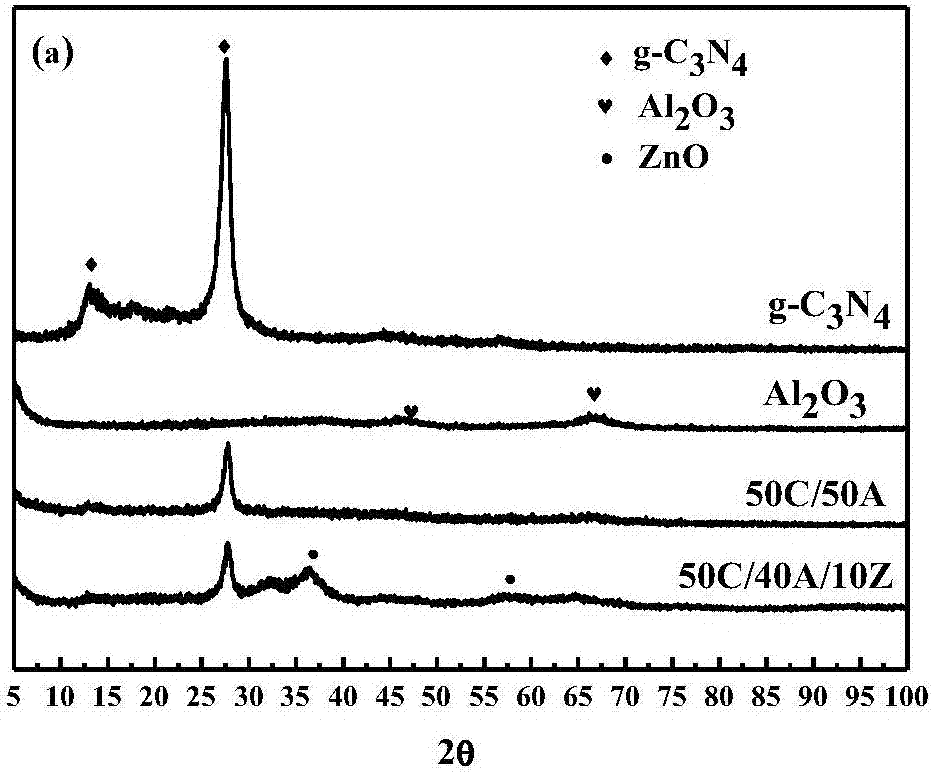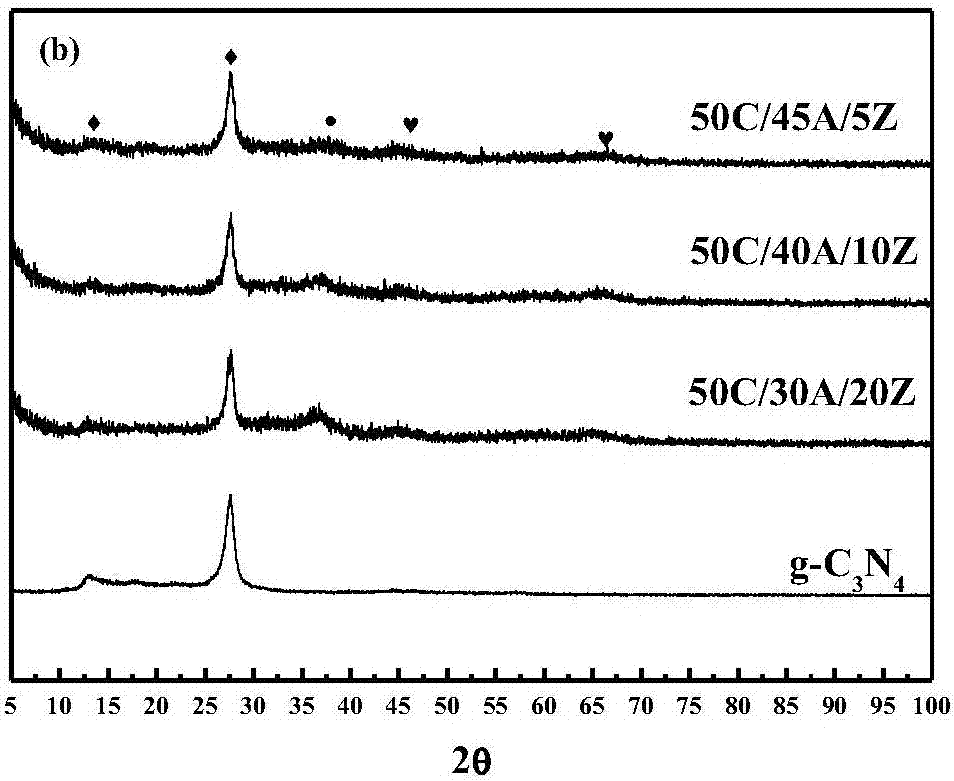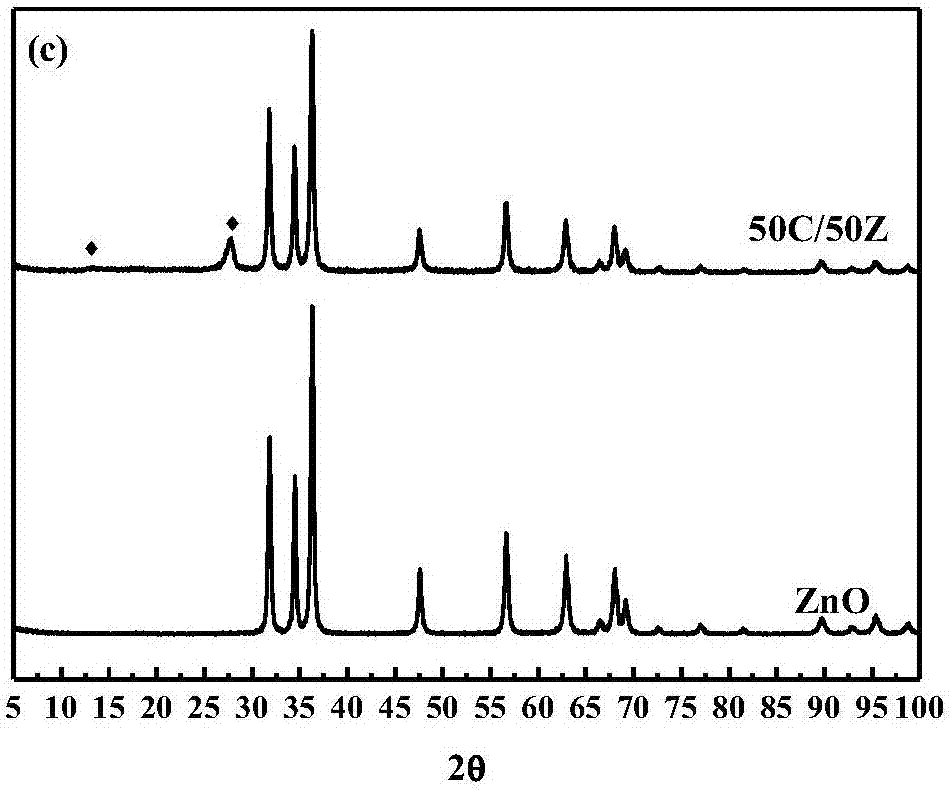G-C3N4/Al2O3/ZnO Heterojunction with visible light catalytic activity and preparation method thereof
A catalytic activity, visible light technology, applied in chemical instruments and methods, chemical/physical processes, light water/sewage treatment, etc., can solve problems such as low quantum efficiency, and achieve the effect of simple preparation process, cheap raw materials, and broadened applications
- Summary
- Abstract
- Description
- Claims
- Application Information
AI Technical Summary
Problems solved by technology
Method used
Image
Examples
Embodiment 1
[0042] Follow the steps below to prepare g-C 3 N 4 / Al 2 o 3 / ZnO ternary heterojunction (the sample is marked as 50C / 40A / 10Z):
[0043] ①Dissolve 0.0047mol of aluminum nitrate in distilled water, then add 0.3g of g-C prepared in the laboratory 3 N 4 (see below for the preparation process), after stirring evenly, add dropwise the NaOH solution of 1mol / L in the beaker, to pH=8-9, continue to stir for 1 hour;
[0044] ②Dissolve 0.00072mol of zinc nitrate in distilled water, and drop it into the turbid solution prepared in step ① simultaneously with 1mol / L NaOH solution, keep the pH=8-9, and continue to stir for 1 hour.
[0045] ③ Suction filter the precipitate obtained in ②, dry and grind to obtain the precursor, which is calcined at 400°C to obtain the desired sample.
[0046] The samples were tested by XRD, UV-Vis DRS, FESEM and HRTEM respectively. The test patterns are shown in Figure 1(a), figure 2 , image 3 and Figure 4 shown. Figure 1(a) XRD pattern shows that ...
Embodiment 2
[0071] Follow the steps below to prepare g-C 3 N 4 / Al 2 o 3 / ZnO (marked as 50C / 45A / 5Z) ternary heterojunction:
[0072] ①Dissolve 0.0053mol of aluminum nitrate in distilled water, then add 0.3g of g-C prepared in the laboratory 3 N 4 After stirring evenly, add dropwise the NaOH solution of 1mol / L in the beaker, to pH=8-9, continue stirring for 1 hour;
[0073] ②Dissolve 0.00036mol of zinc nitrate in distilled water, drop it into the turbid solution prepared in step ① simultaneously with 1mol / L NaOH solution, keep the pH=8-9, and continue to stir for 1 hour.
[0074] ③ Suction filter, dry, and grind the precipitate obtained in ② to obtain the precursor, which is calcined at 400°C to obtain the desired sample 50C / 45A / 5Z.
[0075] The samples were tested by XRD and UV-Vis DRS respectively, and the test patterns are shown in Figure 1(b) and figure 2 shown. Figure 1(b) XRD pattern shows that sample B consists of g-C 3 N 4 , ZnO and Al 2 o 3 Composed of three parts, d...
Embodiment 3
[0079] Follow the steps below to prepare g-C 3 N 4 / Al 2 o 3 / ZnO (marked as 50C / 30A / 20Z) ternary heterojunction:
[0080] ①Dissolve 0.0035mol aluminum nitrate in distilled water, then add 0.3g g-C prepared in Example 1 3 N 4 After stirring evenly, add dropwise the NaOH solution of 1mol / L in the beaker, to pH=8-9, continue to stir for 1 hour;
[0081] ②Dissolve 0.00144mol zinc nitrate in distilled water, and drop it into the turbid solution prepared in step ① simultaneously with 1mol / L NaOH solution, keep the pH=8-9, and continue stirring for 1 hour.
[0082] ③ Suction filter, dry, and grind the precipitate obtained in ② to obtain the precursor, which is calcined at 500°C to obtain the desired sample 50C / 30A / 20Z.
[0083] The samples were tested by XRD and UV-Vis DRS respectively, and the test patterns are shown in Figure 1(b) and figure 2 shown. Figure 1(b) XRD pattern shows that the sample consists of g-C 3 N 4 , ZnO and Al 2 o 3 It consists of three parts.
[...
PUM
| Property | Measurement | Unit |
|---|---|---|
| decolorization rate | aaaaa | aaaaa |
| decolorization rate | aaaaa | aaaaa |
| decolorization rate | aaaaa | aaaaa |
Abstract
Description
Claims
Application Information
 Login to View More
Login to View More - R&D
- Intellectual Property
- Life Sciences
- Materials
- Tech Scout
- Unparalleled Data Quality
- Higher Quality Content
- 60% Fewer Hallucinations
Browse by: Latest US Patents, China's latest patents, Technical Efficacy Thesaurus, Application Domain, Technology Topic, Popular Technical Reports.
© 2025 PatSnap. All rights reserved.Legal|Privacy policy|Modern Slavery Act Transparency Statement|Sitemap|About US| Contact US: help@patsnap.com



